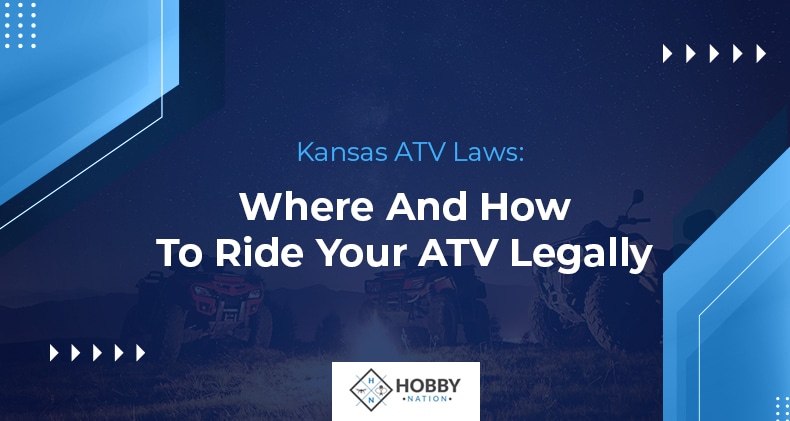Kansas is located in the Mid-western part of the United States of America. To the north, it is bordered by Nebraska, to the south, Oklahoma, to the west, Colorado, and the east, Missouri. There are laws and regulations in Kansas to control the operation of ATVs in the state.
The most crucial ATV law in Kansas is that it is prohibited to operate an all-terrain vehicle on any federal or state road. However, you can operate an ATV on public streets. You can legally ride an ATV in Syracuse Sand Dunes, Kansas Badlands, Perry Lake Trail, Venango Park Trail, and Riverside ATV Park.
Kansas has some of the most complicated ATV laws, and for you to experience a hitch-free ride in the state, you must have comprehensive knowledge of the laws and regulations.

Kansas ATV Laws
According to Kansas laws, an ATV is a non-highway vehicle with a width of 48 inches or less with a dry weight of 1000 pounds or less, travels on at least three low-pressure tires, and has a seat that is straddled by the rider. Let us look at some of the ATV Laws in Kansas.
- All ATVs must be registered with the Kansas Department of Revenue, and you must receive a title for the vehicle.
- You cannot trade-in or sell an ATV unless it is titled in the seller's name.
- There is an ultimatum of thirty days to apply for a title if you recently purchased an ATV.
- It is illegal to operate an ATV in a manner that poses a threat to the safety of other people.
- You do not need to get your ATV titled if you have owned it since the 30th of June 1996 or prior to this date.
- ATVs are prohibited from operating on any federal, interstate, or state highway and roads.
- If your ATV is three-wheeled, you must register it as a motorcycle.
- It is prohibited to operate an ATV when under the influence of drugs or alcohol.
- ATVs can be ridden on marked roads or trails only when within state parks and lands.
- You must not operate your ATV at a speed that exceeds the stated limit on state and public lands.
- There are no age restrictions on who can operate an ATV.
- You can ride an ATV on public streets only if you possess a valid driver's license.
- Riding an ATV on a public road between sunset and sunrise is prohibited, except it has functioning headlights and tail lights. The headlight must be located at a height not less than 24 inches or more than 54 inches, and the tail light must be not less than 15 inches or more than 72 inches.
- The tail light of any ATV operated between sunset and sunrise must lighten up the rear registration plate; if it does not, a separate light must be installed to illuminate the registration plate in white light. It must be legible from a distance of 50 feet.
- If you are operating an ATV on any roadway, it must be equipped with tail lights, headlights, a horn, brakes, side mirrors, turn signals, and a muffler.
- All ATV owners must pay taxes; however, the ATV must meet the following requirements to get an ATV tax exemption for agriculture.
- It must be equipped with a cargo box or a bed.
- It must be wider than 48 inches but not more than 135 inches.
- It must have four or more low-pressure tires.
- It must have a bucket or bench-type seat that allows a minimum of 2 people to sit side by side.
- It must have a steering wheel.
- It must have a dry weight of not more than 800 pounds.
- You can operate an ATV on the streets, county, and town roads of second-class or third-class cities; these are cities with less than 15,000 residents.
- Operating an ATV on the streets of first-class cities is prohibited. A first-class city is a city with a population of more than 15,ooo residents.
- You can operate an ATV on any city street if the city gives an overruling allowance on the use of ATVs.
Kansas, as a state, places restrictions on ATV operations on the streets of first-class cities. However, the city you may be residing in overrules that restriction. So, you can operate your ATV in the streets.
Where Can’t You Ride An ATV In Kansas?
As stated earlier, it is illegal to ride an ATV on any federal, state, or interstate highway or road. It is also illegal to operate an ATV on the streets of any first-class city, except the city makes a law that allows ATVs to be operated on the streets. You must keep this in mind when you ride an ATV in Kansas.

Where Can You Ride An ATV In Kansas?
Now that you know where ATVs are not allowed to be operated, let us look at places where ATVs are allowed and welcomed in Kansas. You are guaranteed to enjoy these locations as an avid ATV rider.
Perry Lake ATV Trail
This trail is one of the most popular ATV trails in Kansas, and it offers about 140 acres of land available to ATVs and motorcycles. This trail is open every day from dawn to dusk, and the terrain available includes wood trails, rugged and steep hill climbs, and deep mud puddles.
The trails are segregated into sections, separating the beginners' trails from the professional riders' trails. The beginner trail has little tracks with small jumps, while the professional has more advanced and difficult trails. There is no fee to ride an ATV on Perry Lake Trail. Riding is allowed only during daylight. The trails may be closed temporarily during wet weather conditions.
Kansas Badlands
Kansas Badlands is also a popular ATV trail park and is open every day, all year-round. Motorcycles, dirt bikes, ATVs, side-by-sides, UTVs, Jeeps, SUVs, Sand Rail 4×4, and Dune Buggy, are allowed in Kansas Badlands. You also need to wear an MX helmet to ride an ATV in this park.
Kansas Badlands offers 254 acres of land for ATV tracks and trails. This park is more suited for novices and amateurs than experts. Most of the trails are for beginners. It costs $5 to gain entry into the park to ride an ATV, and it costs $10 to gain entry during special events.
Riverside ATV Park
This park is a 157-acre land located on the east of the Kansas River, and it offers 20 miles of narrow ATV trails, a motocross track, and a play area. Motorcycles, dirt bikes, ATVs, side-by-sides, and UTVs are permitted in the park. However, Jeeps, SUVs, Sand Rail 4×4, and Dune Buggy are prohibited.
The terrain in Riverside Park includes loose dirt, hard park, mud, dust, rocks, steep hills, small jumps, large jumps, berms, and single tracks. Access to this ATV park is free. Riverside ATV Park is maintained and managed by the Shawnee County Trail Riders Club.
Venango Park Trail
This park is located on the east of Kanopolis Lake in Kansas, which is 30 miles southwest of Salina. This is one of the smallest ATV trails in Kansas, offering about 5 acres of trails and small hills.
Motorcycles, dirt bikes, ATVs, side-by-sides, and UTVs are permitted in the park. Nevertheless, Jeeps, SUVs, Sand Rail 4×4, and Dune Buggy are prohibited. Admission to the Venango Park trail is free and is open every day from 8 pm to sunset.
Final Thoughts
Kansas is one of the best states for ATV trails and tracks. There are many stunning locations where you can ride your ATV. However, the most important thing is to comply with the ATV laws in Kansas. The repercussions for violating any of Kansas ATV laws are not friendly at all; you could be heavily fined, have your ATV impounded, or serve jail time.
Keep Reading:
Shawn Manaher loves to play with new toys and dive into new hobbies. As a serial entrepreneur, work definitely comes first but there is always room for hobbies.

